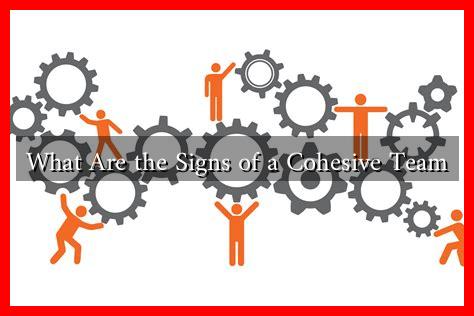-
Table of Contents
What Are the Signs of a Cohesive Team?
In today’s fast-paced business environment, the importance of teamwork cannot be overstated. A cohesive team not only enhances productivity but also fosters a positive work culture. But what exactly are the signs of a cohesive team? This article delves into the key indicators that demonstrate a team’s unity and effectiveness, supported by research and real-world examples.
Understanding Team Cohesion
Team cohesion refers to the bonds that hold a group together, enabling them to work effectively towards common goals. According to a study published in the *Journal of Applied Psychology*, cohesive teams are more likely to achieve higher performance levels and exhibit greater job satisfaction. But how can you identify a cohesive team? Here are some key signs:
1. Clear Communication
Effective communication is the backbone of any successful team. Cohesive teams exhibit:
- Open Dialogue: Team members feel comfortable sharing ideas and feedback without fear of judgment.
- Active Listening: Members actively listen to each other, ensuring that everyone’s voice is heard.
- Regular Updates: Teams hold regular meetings to discuss progress, challenges, and next steps.
For instance, Google’s Project Aristotle highlighted that psychological safety, which stems from open communication, is crucial for team success. Teams that communicate effectively are more likely to innovate and solve problems collaboratively.
2. Shared Goals and Values
A cohesive team has a clear understanding of its objectives and values. Signs include:
- Alignment on Goals: All team members are aware of and committed to the team’s goals.
- Shared Values: Team members resonate with the core values of the organization, fostering a sense of belonging.
- Collective Responsibility: Team members hold each other accountable for achieving shared objectives.
For example, the success of the software company Atlassian can be attributed to its strong emphasis on shared values and goals, which has led to high levels of employee engagement and productivity.
3. Trust and Respect
Trust is a fundamental element of a cohesive team. Signs of trust and respect include:
- Mutual Respect: Team members value each other’s contributions and perspectives.
- Reliability: Team members can depend on each other to fulfill their responsibilities.
- Conflict Resolution: Disagreements are handled constructively, with a focus on finding solutions rather than assigning blame.
A case study of the U.S. Navy SEALs illustrates the importance of trust. Their rigorous training emphasizes building trust among team members, which is critical for success in high-stakes situations.
4. High Engagement and Morale
Cohesive teams often exhibit high levels of engagement and morale. Indicators include:
- Enthusiasm: Team members show excitement about their work and the team’s objectives.
- Low Turnover Rates: Cohesive teams tend to retain their members longer, reducing recruitment and training costs.
- Positive Feedback: Team members frequently express appreciation for each other’s efforts.
According to Gallup, teams with high engagement levels are 21% more productive than their less engaged counterparts. This statistic underscores the importance of fostering a cohesive team environment.
5. Collaborative Problem-Solving
Cohesive teams approach challenges collaboratively. Signs include:
- Collective Brainstorming: Team members come together to generate ideas and solutions.
- Supportive Environment: Team members encourage each other to think creatively and take risks.
- Shared Successes: Achievements are celebrated collectively, reinforcing team spirit.
For example, the design team at IDEO is known for its collaborative approach to problem-solving, which has led to innovative product designs and solutions.
Conclusion
In summary, a cohesive team is characterized by clear communication, shared goals and values, trust and respect, high engagement and morale, and collaborative problem-solving. Recognizing these signs can help leaders foster a more effective and harmonious work environment. By investing in team cohesion, organizations can enhance productivity, innovation, and overall job satisfaction. For further insights on building cohesive teams, consider exploring resources from the *Harvard Business Review* or *Forbes*.

